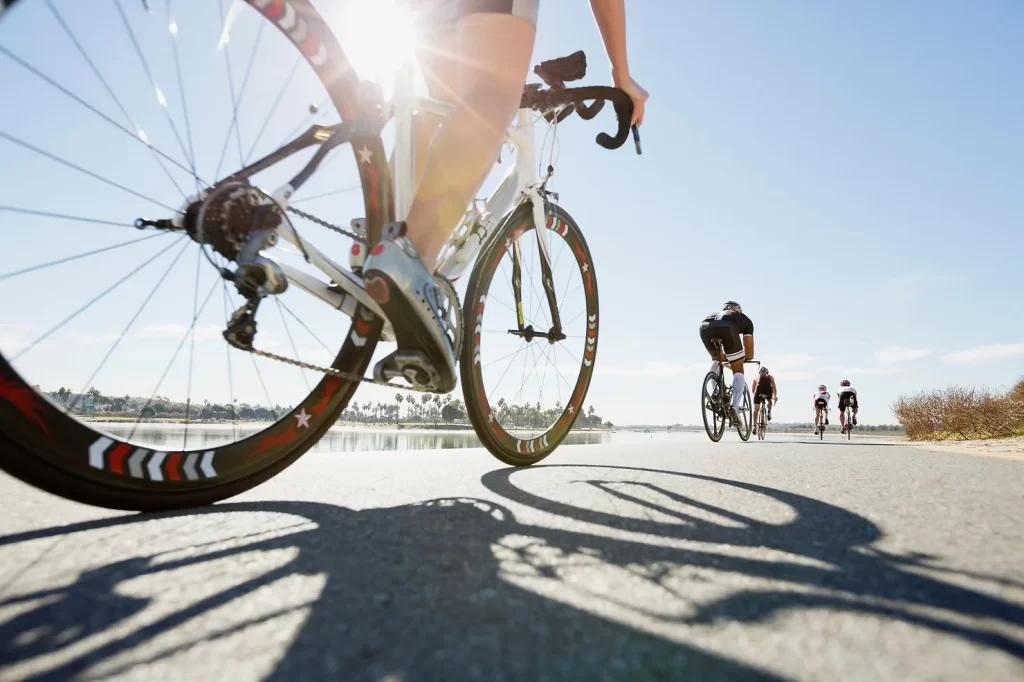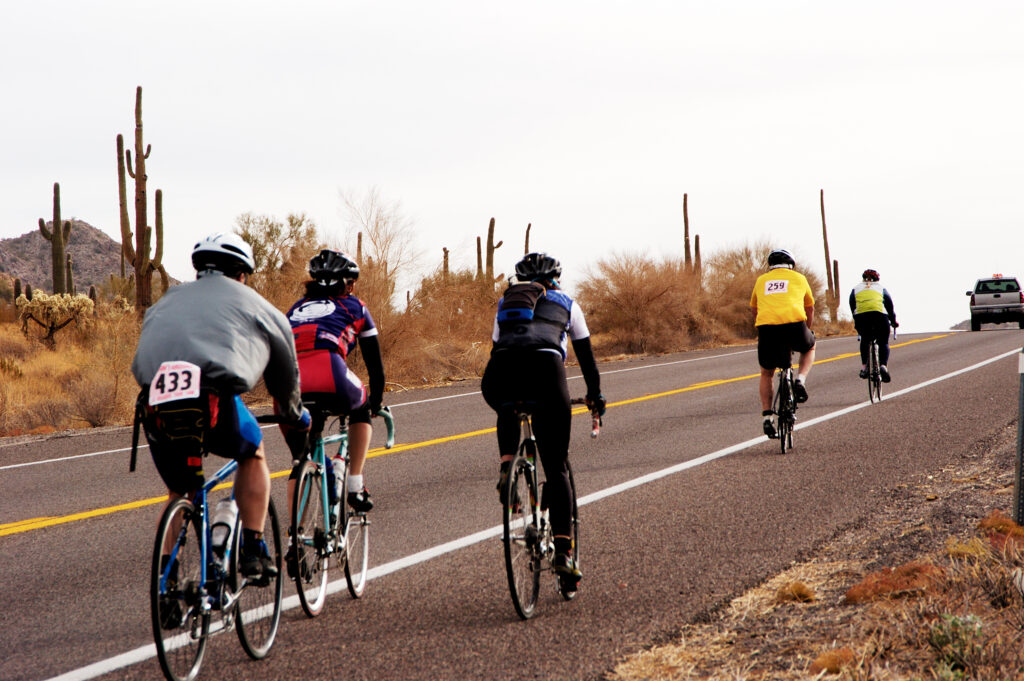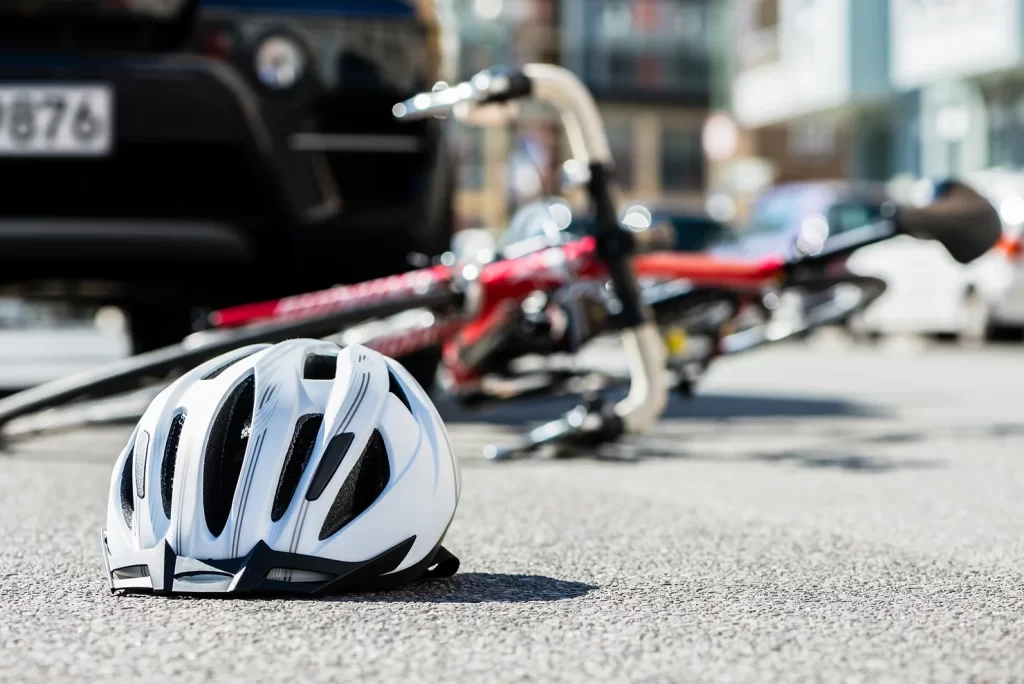Tip 3
Use lights and wear bright or reflective clothing, especially when cycling at night or in low visibility conditions.
Tip 2
Obey all traffic signals and signs, just like a car. This includes stopping at red lights and stop signs.
Tip 1
Always wear a properly fitted helmet to protect your head in case of a fall or collision.
Understanding the Basics of Cycling Laws in California

As a cyclist in California, you have a responsibility to ride safely and responsibly. This means being knowledgeable about the basics of cycling laws in California that govern cycling in the Golden State. Not only will this help keep you and others safe on the road, but it will also ensure that you’re following the rules and avoiding potential fines or penalties. In this blog post, we’ll cover the essential California bicycle laws, nighttime visibility requirements, helmet regulations, and more to help you stay safe and informed on your rides. Key Takeaways Essential California Bicycle Laws As a cyclist, navigating the roads requires strict adherence to specific California bicycle laws. Some fundamental rules include: Following these laws is essential for your safety and the safety of others on the road. Sometimes, it may be necessary to leave the bicycle lane and take up an entire traffic lane. This is allowed when cycling at a slower pace than surrounding traffic, provided it is reasonably safe and the appropriate signal is given. Specific examples of when a cyclist may leave the bike lane include: Adherence to these essential California bicycle laws, as outlined by the California Department under the California Vehicle Code, promotes not only legal compliance but also ensures safety for all road users, with the support of transportation and local authorities. Nighttime Visibility Requirements Cycling in the dark presents additional safety challenges, and California law addresses this by requiring adequate lighting and reflective gear for nighttime visibility. Bicyclists must have a front lamp emitting a white light that is visible from the front and sides of the bicycle. This ensures that motorists can see you coming from a distance, reducing the risk of collisions. In addition to the front lamp, cyclists must also have a rear red reflector that is visible from a distance of 500 feet. This white or red reflector alerts drivers approaching from behind of your presence on the road. To further enhance visibility, a white or yellow reflector can be used on the sides of the bicycle, with the yellow reflector being a popular choice. Compliance with these nighttime visibility requirements significantly enhances your safety during dark rides. Helmet Regulations and Safety California law mandates that cyclists under the age of 18 must wear a helmet while riding a bicycle. This requirement is crucial as it helps protect young riders from severe head injuries in the event of a crash. While adults 18 and older are not legally required to wear helmets, it is strongly encouraged for safety reasons. Wearing a helmet is particularly important when riding in bicycle lanes with heavy traffic, as the risk of collision with motor vehicles increases. A properly fitted helmet can significantly reduce the risk of head injuries in the event of an accident, making it a vital piece of safety equipment for cyclists of all ages. Wearing a helmet, especially if under 18 as required by California law, is a conscious step towards prioritizing safety and well-being while cycling. Proper Bicycle Equipment In addition to helmet regulations, California law has specific provisions regarding proper bicycle equipment. One crucial requirement is having functional brakes that enable a single wheel to skid to a stop on dry pavement. This ensures that you can safely and effectively stop your bicycle when necessary. Another equipment requirement is the appropriate handlebar height. In California, handlebars must not exceed the rider’s shoulder level. This regulation promotes proper riding posture and control, minimizing the risk of accidents caused by an unstable riding position. Equipping your bicycle with functional brakes, proper handlebar height, and other necessary equipment enhances your safety and ensures California law compliance. Rules for Riding on Sidewalks and Bike Paths Riding on sidewalks and bike paths in California is subject to local regulations, which may vary by city or county. Familiarizing yourself with these rules is vital to avoid penalties and maintain safe cycling practices. For example, in Santa Monica, riding a bicycle on the sidewalk is prohibited. In general, there is no statewide law prohibiting cyclists from riding on the sidewalk in California, but bike riders should always yield right-of-way to pedestrians. It is important to consult local ordinances to understand the specific rules and regulations for sidewalk and bike path use in your area. Regardless of local regulations, always remember to ride in the same direction as traffic when on sidewalks or bicycle paths. This reduces the risk of collisions with motor vehicles and other cyclists. Audio Restrictions While Cycling California law places certain audio restrictions on cyclists to ensure they remain aware of their surroundings while riding. Specifically, cyclists are not permitted to wear headsets or earplugs that cover both ears, except in cases of highway operations or when the device is a hearing aid. Wearing headphones or earbuds while cycling can reduce your ability to hear surrounding sounds, increasing the potential for safety hazards. Adherence to these audio restrictions promotes: Sharing the Road with Motor Vehicles Cyclists must share the road with motor vehicles, and California law has specific provisions to ensure the safety of both parties. One such provision is the Three Feet for Safety Act, which requires drivers to maintain at least three feet of clearance when overtaking bicyclists in traffic. If a driver is unable to maintain a 3-foot buffer when passing a cyclist, they must reduce their speed and only pass when it does not present a risk to the cyclist. Cyclists also have obligations when sharing the road with motor vehicles and bicycle passengers. They must ride as close to the right side of the road as practicable, except when passing, making a left turn, avoiding hazards, or if the right side of the road is not suitable for riding. Responsible sharing of the road and adherence to these rules minimizes accident risk and promotes a safer environment for all road users. DUI and Hit-and-Run Consequences for Cyclists Cyclists should be aware that California DUI laws apply to them just as they do to
Do Cyclists Have to Stop at Stop Signs? Everything You Need to Know

Do cyclists have to stop at stop signs? In most places, yes. Cyclists often must follow the same rules as cars, which includes stopping at stop signs. However, some states have different laws allowing cyclists to yield instead. This article will explain the rules for cyclists at stop signs, including differences between states, safety implications, and practical tips. Key Takeaways Cyclists in California must stop at stop signs, similar to motor vehicles, to enhance safety and manage traffic flow. The Idaho Stop Law allows cyclists to yield instead of stopping at stop signs, having shown a significant reduction in bicycle-related injuries in states that implement similar laws. The Bicycle Safety Stop Bill in California aims to allow cyclists aged 18 and over to yield at stop signs, recognizing the unique dynamics of cycling and potentially improving road safety. Understanding Stop Signs for Cyclists Cyclists in California are legally required to stop at stop signs, just like motor vehicles. This means that, under California law, cyclists must come to a complete stop at all stop signs and obey all traffic devices indicating a red light, including traffic lights and traffic signals. The rationale behind this is straightforward: stop signs manage traffic flow and ensure safety at intersections. Stop signs help prevent accidents and enhance safety for all road users, including cyclists, motorists, and pedestrians, by managing the order of traffic. When approaching a four-way stop, cyclists should follow the same right-of-way rules as motor vehicles. This involves taking turns with other vehicles based on the order of arrival. Cyclists must stop behind the stop line at stop signs, ensuring they do not enter the intersection before it is their turn. After coming to a full stop, cyclists may proceed if they have regained their right-of-way. The expectation that cyclists stop at stop signs reinforces a culture of safety among all road users. When cyclists follow these rules, they contribute to a safer, more predictable traffic environment, reducing the risk of accidents and ensuring smoother interactions with other road users. The Idaho Stop Law The Idaho Stop Law, a groundbreaking piece of legislation, permits cyclists to yield at stop signs instead of coming to a complete stop. This law, named after the state that first implemented it, allows cyclists to maintain momentum by treating stop signs as yield signs when the coast is clear. The impact of this law has been significant, with a 14.5% decrease in bicycle-related injuries recorded in Idaho within a year of its implementation. States like Delaware have also adopted similar laws, with impressive results. After implementing stop-as-yield laws, Delaware saw a 23% reduction in bike collisions at stop sign intersections. Research indicates that rolling stops can lead to fewer conflicts between cyclists and motorists, as cyclists can clear intersections more swiftly and predictably, reducing the time spent in potentially dangerous zones. The Idaho Stop Law highlights a shift in how traffic laws can be adapted to better suit the unique dynamics of bicycle movement compared to motor vehicles. These laws enhance safety and traffic flow by allowing cyclists to yield instead of stopping completely, without compromising road order. Bicycle Safety Stop Bill In California, the Bicycle Safety Stop Bill, formally known as Assembly Bill 73, is a legislative effort aimed at enhancing traffic flow and safety for cyclists. This bill proposes that cyclists aged 18 and over be allowed to yield to vehicles and pedestrians when approaching a stop sign, rather than being required to come to a complete stop at certain intersections. The primary goal is to distinguish the operations of bicycles from those of motor vehicles, recognizing the unique needs and behaviors of bike riders. If passed, this legislative change would be effective until January 1, 2031, providing a substantial period to evaluate its impacts on traffic safety and flow. A report evaluating the effects of the proposed bill on traffic safety must be submitted by the California Highway Patrol by 2029, ensuring that data-driven decisions can be made regarding its continuation or modification. This bill recognizes the need to adapt traffic laws for cyclists, potentially reducing bicycle accidents and improving road safety for everyone, including bicycle laws. Consequences of Not Stopping Ignoring stop signs can have serious consequences for cyclists. Failing to stop at stop signs can also lead to dangerous interactions with cross traffic. Cyclists in California can face fines of several hundred dollars for failing to stop at stop signs. Additionally, they can be cited for disobeying traffic signs, which poses a significant risk of accidents. Enforcement of these traffic laws is essential for ensuring cyclist safety and preventing accidents. Many cyclists perform rolling stops to maintain momentum, often due to the infrequent enforcement of stop sign rules by police. However, the risks associated with this behavior are substantial. Failing to stop at stop signs can result in a $130 fine for cyclists, and more importantly, it increases the likelihood of collisions and personal injuries. The legal and safety implications of not stopping highlight the importance of adhering to traffic regulations. Understanding and following these rules helps cyclists create a safer environment for themselves and other road users. Comparing Different State Laws The approach to stop signs for cyclists varies significantly across different states. Delaware’s Yield law permits cyclists to yield instead of stopping at stop signs on two-lane roads. This law, part of the Bicycle Friendly Delaware Act, facilitates cyclists maintaining forward momentum, which enhances visibility and reduces the time they spend at intersections. Several states, including Delaware, Arkansas, and Minnesota, have adopted laws similar to the Idaho Stop that allow cyclists to treat stop signs as yield signs. These laws aim to improve traffic flow for cyclists without compromising safety. The ‘Red Light as Stop’ law in some states allows cyclists to treat red lights as stop signs, enabling safe passage after stopping. In contrast, California has repeatedly vetoed attempts to implement a yield-instead-of-stop approach for cyclists due to safety concerns. This variation in laws across states reflects differing
Maricopa County Cycling: A Guide to Cycling in the Phoenix and Scottsdale Areas

Cycling in Maricopa County, particularly in the vibrant cities of Phoenix and Scottsdale, offers a unique blend of urban and scenic routes, making it a popular activity for both residents and visitors. This guide will provide comprehensive information on cycling laws, accident statistics, popular routes, and safety tips for cyclists in this dynamic region. Table of Contents 1. Introduction Maricopa County is not only the most populous county in Arizona but also one of the fastest-growing regions in the United States. With its extensive network of roads, pathways, and dedicated bike lanes, it provides an excellent environment for cycling enthusiasts. The mild climate, especially during the fall and spring months, makes cycling a year-round activity. However, it’s essential for cyclists to be aware of local laws and safety guidelines to ensure a safe and enjoyable experience. 2. Cycling Laws and Regulations in Maricopa County 2.1 Arizona Vehicle Code Arizona has specific laws that govern cycling to enhance the safety of both cyclists and motorists. Here are some key points from the Arizona Revised Statutes (ARS) relevant to cyclists: 2.2 Local Ordinances Local ordinances in cities like Phoenix and Scottsdale further refine cycling laws to address specific community needs: Understanding and adhering to these laws is crucial for ensuring a safe cycling experience and avoiding potential legal issues. 3. Bicycle Accident Statistics in Maricopa County Accident statistics highlight the importance of safety while cycling in Maricopa County. According to the Arizona Department of Transportation (ADOT) and the National Highway Traffic Safety Administration (NHTSA), the following key statistics have been observed in recent years: These statistics understand the importance of adhering to cycling laws, being aware of surroundings, and implementing safety practices while cycling. In the unfortunate event of an accident, understanding your rights and how to proceed is crucial. 4. Common Cycling Routes in Phoenix and Scottsdale 4.1 Phoenix Cycling Routes Phoenix boasts a variety of cycling routes that cater to different skill levels and preferences. Here are some popular options: 4.2 Scottsdale Cycling Routes Scottsdale is known for its picturesque landscapes and well-maintained bike paths. Here are some of the top cycling routes in the area: 5. Tips for Safe Cycling in Maricopa County To ensure a safe and enjoyable cycling experience in Maricopa County, consider the following tips: 6. How Lawyers 4 Cyclists Can Help In the unfortunate event of a bicycle accident, having the right support is crucial. Lawyers 4 Cyclists specializes in helping cyclists navigate the legal challenges following an accident. Here’s how they can assist you: If you’ve been involved in a bicycle accident in Maricopa County, don’t hesitate to reach out to Lawyers 4 Cyclists for the support you need. 7. Conclusion Cycling in Maricopa County offers a wonderful opportunity to explore the vibrant cities of Phoenix and Scottsdale while enjoying the beautiful Arizona landscape. By understanding local laws, being aware of accident statistics, and choosing safe cycling routes, riders can make the most of their cycling experience. Remember to prioritize safety and stay informed about regulations. In case of an accident, Lawyers 4 Cyclists is here to help you navigate the complexities of your situation, ensuring your rights are protected and you receive the compensation you deserve. Whether you’re commuting, exercising, or enjoying a leisurely ride, having knowledgeable legal support can make a significant difference in the aftermath of a cycling accident. With their expertise, Lawyers 4 Cyclists can help you focus on recovery while they handle the legal intricacies, providing peace of mind during a challenging time. By equipping yourself with knowledge about cycling laws, staying informed on safety practices, and knowing where to turn for help in case of an accident, you can make the most of your cycling experience in Maricopa County. Embrace the joy of cycling while remaining vigilant, and remember that Lawyers 4 Cyclists is dedicated to advocating for the rights of cyclists throughout Arizona. This comprehensive guide aims to empower cyclists in Maricopa County, ensuring they have the necessary tools and information for safe riding. Happy cycling!
10 Essential Laws to Know When Traveling with Bicycle in 2023

Cycling has become increasingly popular as a mode of transportation, especially when traveling. It’s an eco-friendly, fun, and healthy way to explore new places. But have you ever wondered about the different laws and regulations that apply to bicycles when you’re on the move? In this blog post, we’ll dive into the essential “laws to know when traveling with a bicycle”, covering topics like bike transportation, statewide bicycle laws, bike lanes, international cycling laws, etiquette, safety tips, and local resources. So, saddle up and let’s get started! Key Takeaways Bike Transportation Laws and Regulations Various transportation laws and regulations will come into play when you travel with your bike. These distinct rules, depending on whether you’re using a car bike rack, taking public transit, or flying with your bicycle, are crucial to know to avoid fines or complications. Now, let’s examine each mode of transportation, including motor vehicles, in detail. Car Bike Racks Car bike racks make it easy to transport your bicycle by attaching it to the back of your car securely. However, different states and regions may have specific laws and regulations for car bike racks. Here are some important considerations: It’s important to familiarize yourself with the laws and regulations in your area to ensure safe and legal transportation of your bike using a legal vehicle. Driving with a bike rack calls for extra caution, especially when approaching a left turn lane, as cyclists could be nearby. Being well-versed in local laws and regulations when using car bike racks as a cyclist can help evade fines and guarantee a hassle-free journey. Bikes on Public Transit Bikes on public transit are bicycles that you can take with you on public transportation, such as buses, trains, and subways. However, the rules for bikes on public transit vary by location. Generally, there are limits on the size and type of bike allowed, plus how many bikes per vehicle. Cyclists should also be aware of any specific travel lane restrictions or requirements. To find bike spots on public transit, look for signs or other indicators at the front or back of the vehicle. When using public transit, keep in mind any applicable rules and regulations, like time restrictions or permit requirements. Familiarizing yourself with these rules can help ensure a seamless journey for both you and your fellow commuters. Flying with Bicycles Before flying with your bicycle, confirm with the airline that you meet all their requirements. The laws and regulations for flying with bikes vary between airlines and destinations, and may involve proper packaging, additional fees, and adherence to specific regulations. Avoid travel complications by researching your airline’s policies and preparing your bike to meet the requirements. Statewide Bicycle Laws Awareness of the statewide laws, including state laws regarding bicycle laws, of your travel destination is vital. These laws cover helmet requirements, traffic laws, and equipment regulations, which can vary between states or countries. Comprehending and adhering to these laws contributes to your safety and that of others on the road. Helmet Requirements Helmet requirements may differ by age, location, or type of cycling activity. For example, in many US states, children are required to wear helmets when cycling. In some cities, such as Aberdeen, Bainbridge Island, Bellevue, Bremerton, DuPont, Eatonville, Fircrest, and Gig Harbor, all cyclists must wear helmets. Regardless of the local laws, it’s always a good idea to wear a helmet for your safety and protection while cycling. A helmet can significantly reduce the risk of head injuries in the event of an accident and can also help you comply with any local helmet requirements. Traffic Laws Traffic laws for cyclists typically include obeying traffic signals, riding in the same direction as traffic, and yielding to pedestrians. In Germany, for instance, cyclists must follow the same traffic laws as other road users, including those concerning drink driving, and they can even lose their driver’s license if they have one. No matter where you’re cycling, being aware of and adhering to traffic laws is crucial. This ensures your safety and the safety of other road users, as well as helps maintain a positive cycling environment. Equipment Regulations Equipment regulations often mandate specific safety features on bicycles, such as lights, reflectors, and bells. For example, in the UK, all bikes sold must come with wheel reflectors, a red wide-angle rear reflector, and amber reflectors front and rear on each pedal. Adhering to equipment regulations helps guarantee your safety and that of others on the road. Proper lighting and reflectors increase your visibility to other road users, while bells or horns can help alert pedestrians and other cyclists to your presence. Bike Lanes and Roadway Rules Bike lanes and roadway rules play a crucial role in ensuring safe cycling and coexistence with motor vehicles and pedestrians. Comprehending and abiding by these rules contributes to a safer and more pleasurable cycling experience for all road users. Proper Bike Lane Usage Proper bike lane usage involves riding in the designated direction, yielding to pedestrians, and avoiding obstructions like parked cars or debris. This helps ensure the safety of cyclists and other road users, as well as promotes the efficient use of bike lanes. Sharing the Road with Motor Vehicles Sharing the road with motor vehicles requires awareness, communication, and adherence to traffic laws. Motor vehicle operators and cyclists riding predictably, maintaining a safe distance from each other, and being prepared to yield when necessary is crucial. Motorists, on the other hand, should give cyclists at least three feet of space when passing and be aware of their presence on the road. By following these guidelines, cyclists and motorists can coexist safely on the road, reducing the chances of accidents or conflicts. Bear in mind, cyclists and motorists share equal rights and responsibilities on the road. Navigating Intersections Navigating intersections safely involves signaling your intentions, positioning yourself correctly within the bike lane or travel lane, and following traffic signs and signals. By doing so, you increase your visibility to other road users
Bicycle Accidents in Southern Orange County

Did you know that Orange County has seen a significant increase in bicycle accidents, with thousands of crashes and numerous fatalities reported in recent years? This startling fact sheds light on the importance of understanding and addressing the issue of bicycle accidents in Orange County. In this blog post, we will write an optimized blog about bicycle accident in Orange County, exploring the reality of bicycle accidents, safety measures, legal rights and responsibilities, and practical tips for cyclists to prevent accidents and stay safe on the road. Short Summary READ MORE
The Golden Rules of the Road

Whether it’s your first ride or you’ve been riding for years, every cyclist wants a safe and enjoyable experience. That’s why it’s so important to master the bicycle laws of the golden state…before you hit the road. In doing so, you’ll help ensure a safer experience for yourself and those around you, while fostering a positive image of cyclists in your community. And what can be more golden than that? The Right Side: Riding on the right side of the road is not only a legal requirement of California, but also a crucial aspect of group ride safety and efficiency. Cyclists must ride on the right side of the road, in line with the traffic flow, with the exception of making a legal left turn, passing other cyclists, riding on a one-way street, when going down a road too narrow to share, or when the right side of the road is blocked off for construction. The Right Equipment: In California, certain equipment requirements must be met for a safe and legal cycling experience. Cyclists are required to have a white front light and a red rear reflector or light for nighttime use. Additionally, helmets that comply with the American National Standards Institute (ANSI) or the Snell Memorial Foundation standards must be worn by riders under the age of 18. Know the Signs: Obeying traffic signals and signs is essential for cyclists in California, as it guarantees the safety of all road users and helps prevent accidents. Cyclists must comply with all traffic signals and signs, including stop signs, yield signs, and traffic lights, just like any other vehicle on the road. During group rides, it’s particularly important to accommodate slower riders and maintain a safe and inclusive environment for everyone involved. Failing to adhere to traffic signals and signs can result in fines or other penalties, as well as create dangerous situations for both cyclists and motorists. Sidewalk Dos and Don’ts: While there is no state-level prohibition against sidewalk cycling in California, it’s essential to check local ordinances in your area for any additional regulations. Cycling on sidewalks can pose risks due to the presence of pedestrians, cars, and other cyclists, so it’s important to be mindful of your surroundings and adhere to the rules of the road when doing so. Common Violations and Penalties: Some of the most common bicycle-related violations in California include riding against the flow of traffic, navigating on the incorrect side of the road, failure to yield, disregarding red lights or stop signs, riding while under the influence, not using lights during night hours, and not wearing a helmet when required. Penalties for these violations can range from a warning to a fine of up to $250. By adhering to traffic laws and practicing safe cycling habits, you can avoid these violations and enjoy a trouble-free ride. Don’t be afraid to ask: Experienced riders can provide valuable insights and advice on local cycling regulations, so don’t hesitate to ask for guidance from your fellow cyclists or local bike shop. By following the golden rules and sharing the road responsibly with motorists, you’ll set yourself up for success and foster a positive cycling community.
How to Navigate Biking on Sidewalk: Rules and Tips

Wondering if BIKING ON SIDEWALK is allowed and safe? Many cyclists prefer sidewalks to busy streets, but this choice comes with specific rules and risks. This article explores the legal aspects, safety measures, and best practices for riding on sidewalks, including the nuances of BIKING ON SIDEWALK. KEY TAKEAWAYS Sidewalk cycling poses unique safety risks, including reduced visibility and potential conflicts with pedestrians, making it crucial for cyclists to assess local regulations and traffic conditions before riding. Local laws regarding sidewalk cycling vary significantly; cyclists must be well-informed about specific regulations in their area to avoid legal issues and ensure safe biking practices. Cyclists are advised to yield to pedestrians, use audible signals when passing, and prefer bike lanes when available to enhance safety and comply with local traffic laws. Understanding Biking on the Sidewalk Sidewalk cycling, the act of riding a bicycle on designated pedestrian walkways, is a practice that often stirs debate. While sidewalks are primarily designed for pedestrian use, many cyclists find themselves using these paths for various reasons—be it safety concerns on busy roads or a lack of dedicated bike lanes. However, this practice brings its own set of challenges and risks. Cyclists on sidewalks face unique safety hazards, including reduced visibility at intersections and driveways, and potential conflicts with pedestrians. In fact, many areas expect adults to ride on the street rather than on sidewalks to mitigate these risks. For instance, New York City generally discourages sidewalk cycling due to high pedestrian traffic. Understanding these nuances is the first step in ensuring safe and legal rides. Safety Considerations for Sidewalk Cycling Safety is paramount when it comes to sidewalk riding. Cyclists must navigate a host of potential hazards, from unexpected encounters with pedestrians to visibility issues at intersections. It’s essential to assess whether sidewalk cycling is the safest option based on local regulations and the density of pedestrian traffic. Let’s delve into some specific safety considerations. Visibility Issues Reduced visibility is a significant concern for cyclists on sidewalks. When riding on sidewalks, cyclists often find themselves less visible to vehicles, particularly at intersections and driveways. This decreased visibility increases the risk of accidents, as drivers may not expect a cyclist to be crossing their path. Cyclists need to exercise extra caution and make sure they are visible to oncoming traffic. Driveway and Intersection Risks Cyclists face significant risks at driveways and intersections. Vehicles exiting driveways or nearing intersections might not expect bike traffic, increasing the chance of accidents. Cyclists should slow down, remain vigilant, and be ready for sudden vehicle movements. Crossing from a sidewalk to the road requires awareness of oncoming traffic and a cautious approach. Pedestrians Conflicts with pedestrians are another critical issue in sidewalk riding. Crowded sidewalks, obstacles, and limited space can lead to accidents. Cyclists should consider dismounting and walking their bikes at busy intersections to avoid collisions. Minimizing conflicts and ensuring safety on shared pathways involves respecting pedestrian space and exercising patience. Obeying Local Laws Local laws regarding sidewalk cycling can vary significantly, making it vital for cyclists to be well-informed. Different states and municipalities have their own regulations, and what is permitted in one place may be prohibited in another. Knowing these local laws helps avoid legal issues and promotes safe cycling practices in accordance with local ordinance. Always remember to check local laws. State and local regulations can differ widely when it comes to sidewalk cycling. California, for example, lacks a uniform state law for bicycle use, so local jurisdictions set specific rules. In contrast, New York City generally restricts sidewalk cycling to children under 13 and certain small-wheeled bicycles. Pennsylvania allows sidewalk cycling unless local regulations state otherwise. Knowing these distinctions is crucial for legal compliance. Due to the variability in local laws, cyclists should verify regulations in their specific area. For example, New York City prohibits riding on sidewalks unless explicitly allowed by signage. New Jersey does not ban sidewalk cycling at the state level, but some municipalities have local prohibitions. Additionally, several states require cyclists to give an audible warning before overtaking pedestrians. Examples of varying local laws underscore the need to stay informed. In New Jersey, some local governments ban sidewalk cycling despite state permissions, whereas New York City permits it only in certain areas. Resources like the Bike League provide comprehensive overviews of bike law, bicycle laws, and state laws across states, aiding cyclists in navigating these complexities. Major states have their own specific rules regarding sidewalk cycling, reflecting diverse approaches to regulation and sidewalk cycling vary, along with separate laws. Consider the specific rules in California, New York, and Florida. California In California, the absence of a statewide law on sidewalk cycling means local ordinances are crucial. Regulations can vary significantly between cities and counties, with some areas allowing sidewalk cycling only on designated bike routes. Cyclists must be aware of local rules to prohibit riding and ensure compliance. New York New York’s regulations are stringent, particularly in New York City, where sidewalk cycling is generally illegal except under specific circumstances. Cyclists must adhere to traffic laws, including obeying signals and signs, and ride with traffic. Motorists must treat cyclists with the same rights and responsibilities as other motor vehicle, promoting mutual safety. Safety gear requirements, such as functional brakes and lights, are also enforced. Florida In Florida, cyclists are generally allowed to ride on sidewalks unless local ordinances prohibit it. However, cyclists must yield to pedestrians and follow additional local regulations for safe riding. Business Districts and Restricted Areas Business districts and high-traffic areas often have specific restrictions on sidewalk cycling. Local ordinances typically dictate whether cyclists can ride on sidewalks in these areas. For example, Pennsylvania allows sidewalk riding unless local laws prohibit it, which is common in populated areas. States like Hawaii and Missouri restrict sidewalk cycling in business districts, expecting cyclists to use the road instead. Cyclists have specific rights and duties when riding on sidewalks. They must yield to pedestrians, follow local traffic laws, and


